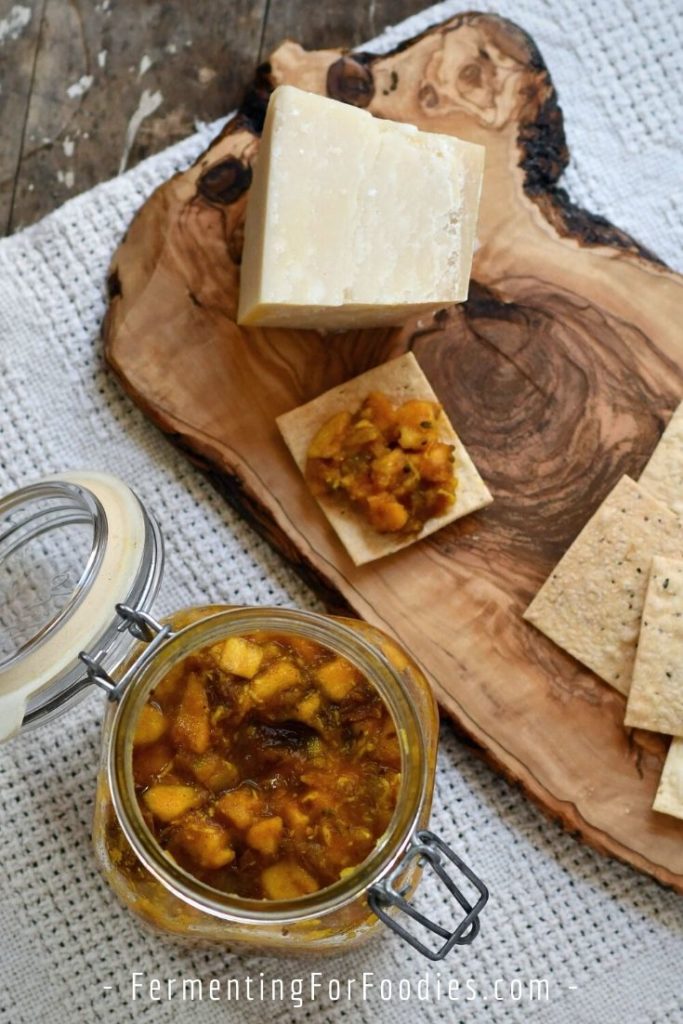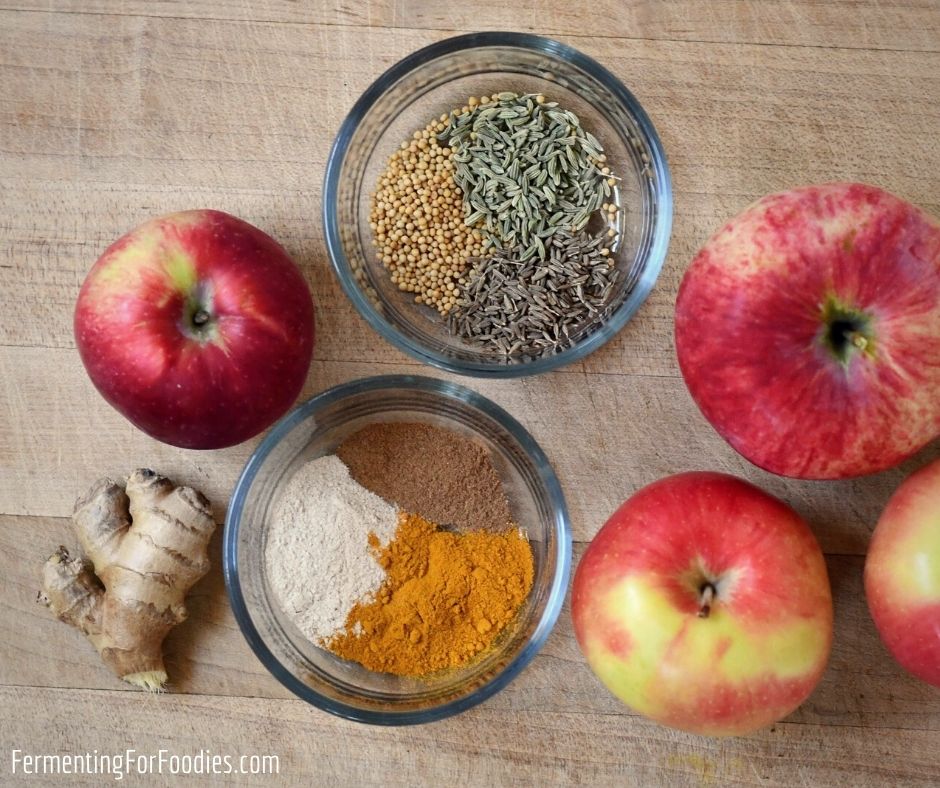This simple fermented apple chutney is preserved with cider vinegar or kombucha. It is naturally sweet, spicy, and delicious!

Homemade apple chutney is a delicious way to preserve the bounty of an autumn apple harvest. This recipe is warm and richly spiced. The sweetness of apples and dates is balanced by the addition of apple cider vinegar.
Best of all, this recipe uses fermentation, rather than cooking, to blend the flavors and preserve the chutney. It’s a really simple recipe, even if you’ve never fermented anything before. The secret to this fermented apple chutney is raw apple cider vinegar, which naturally ferments and preserves apples!
How To Serve Chutney
This apple chutney is one of my favorite apple recipes. I also like making apple cake and a fermented apple spread.
I usually make a triple batch and freeze it in straight-sided, 1-cup mason jars (I think they’re officially salmon canning jars). That way we can enjoy the chutney throughout the year.
Apple chutney is a versatile condiment that adds flavor to all sorts of dishes:
- Chutney is delicious with an Indian meal. Serve it with samosas, pakoras or poppadoms.
- It’s a simple addition to a cheese platter or charcuterie board.
- Try a cheese and chutney sandwich.
- Puree the apples for a smooth sauce that is a flavorful alternative to ketchup or relish. Serve it anytime you want a sweet and tangy sauce. Perfect with fries, hamburgers, and hot dogs
Cooked Chutney
The original version of this recipe involved cooking the apples prior to fermenting. However, I got tired of the two-step process, so I updated the recipe to involve fermentation only.
If you were a fan of the cooked version, here are the instructions:
- Heat 1/4 cup of vegetable oil in a saucepan and add the seeds. When they smell fragrant add the ginger.
- Heat for one more minute, then add the apples with the powdered spices. Toss to coat the apples in spices.
- Pit and finely chop the dates. Add them to the apples with 1/4 cup of water. Simmer until the apples are cooked and the chutney has thickened.
- The chutney can be used right away. Or leave it to cool to room temperature, then ferment as described in the recipe below.

Simple Fermented Apple Chutney
This simple apple chutney is fermented with cultured cider vinegar or kombucha. Don’t let the long list of spices scare you. Feel free to omit any that you don’t happen to have in your kitchen. It will still taste delicious!
- Prep Time: 15 minutes
- Cook Time: 20 minutes
- Total Time: 35 minutes
- Yield: 1 pint jar 1x
- Category: Condiment
- Method: Cooked
- Cuisine: Indian
- Diet: Vegan
Ingredients
- 1/4 cup raw apple cider vinegar or kombucha (see notes)
- 1/4 to 1/2 cup of water, chlorine-free
- 4 medium apples
- 1/2-inch fresh ginger root
- 1 tsp mustard seeds
- 1 tsp cumin seeds
- 1 tsp fennel seeds
- 1/2 tsp asafoetida (optional)
- 1 tsp cardamom powder
- 1/2 tsp cinnamon
- 1/2 tsp turmeric
- 1/4 tsp cayenne (optional)
- 6 dates (see notes)
- 1 tsp salt, to taste
Instructions
- Mix the apple cider vinegar and 1/4 cup of water in a 1-quart jar. The recipe only makes 2 cups, but you will need lots of space to stir your apples.
- Peel, core, and chop the apples. I recommend using a mix of soft and hard apples as they will give the chutney a nice consistency. Add the apples to the jar, and toss to coat in the liquid. Peel and finely grate the ginger. Add it to the jar as well.
- There are a lot of spices in this recipe. Feel free to skip any that you don’t already have in your kitchen. The chutney will still taste amazing! Heat a dry frying pan on medium. When it is warm add the seeds and toast until they start to smell fragrant, about 2 minutes. Add the powdered spices and heat for 1 more minute. Be careful not to burn the spices. Remove from the heat as soon as you start to smell them.
- Pit and finely chop the dates. Stir the dates and spices into the jar. Mix well so that all the apple pieces are coated in spice. Pack the fruit down into the jar. The goal is to have the apples fully below the fermentation liquid. Depending on the juiciness of the apples you may need to add a few more tablespoons of water.
- Place the jar in a cool dark location to ferment for 3 to 5 days. Cover with a loose lid or a piece of cloth held in place with a rubber band. If you use apple cider vinegar it won’t bubble quite as much as kombucha, however, it’s important to let the carbonation escape.
- Stir in the salt after fermenting. Cap with an air-tight lid and store in the refrigerator for up to 1 month or freeze for up to 3 months.
Notes
- The asafoetida and cayenne pepper can easily be omitted without impacting the overall flavor of the chutney. There are so many spices in this chutney that you can skip one or two of them without greatly impacting the overall flavor.
- The dates are used to sweeten the chutney. For an even sweeter chutney, skip the dates and add a 1/4 cup of raw sugar instead.
- It’s important to use raw, unpasteurized apple cider vinegar
. Not all brands will work, so be sure the read the label. The ACV can be replaced by unflavored kombucha or a different probiotic beverage.
- Salt will slow down the fermentation in this recipe, which is why it is added after fermenting.
Nutrition
- Serving Size: 2 Tbsp.
- Calories: 42
- Sugar: 7.8g (less after fermenting)
- Sodium: 149 mg
- Fat: 0.3g
- Saturated Fat: 0g
- Carbohydrates: 10.5g
- Fiber: 1.8g
- Protein: 0.3g
- Cholesterol: 0mg




I love this chutney. I served it with popadoms at a party and everyone raved.
So lecker, ich könnte das Chutney morgens, mittags und abends mit einem großen Löffel einfach so essen, yum yum yum!
Grüße,
Jesse-Gabriel
Thanks! It really is one of my favourite recipes!
Hi Jeff,
I had never heard about these negative side effects of asafoetida before… so I did a bit of googling. It seems that your concerns are more related to asafoetida supplements than culinary use. It is quite a strong flavour, so it is seldom added in large quantities to a dish. As well, culinary asafoetida is a mix of ingredients, including flour or turmeric. So it isn’t as concentrated as a supplement would be. However, if you (or anyone else) is concerned, this recipe is still delicious without asafoetida! Be well, Emillie
I’m wondering how this can ferment when you use vinegar? Research shows vinegar kills bacteria so not to buy any pickle that has
vinegar in it. Only buy pickle, like sour kraut for example that has only some salt added then fermented. Please advise.
Hi Diana, You are right, things that are pickled with vinegar are not typically fermented. However, vinegar doesn’t necessarily completely stop all fermentation. For example, a little be of vinegar can be used to lower the pH to ensure a mould-free ferment (like in tempeh). In this case, live-cultured ACV is the culture for the ferment. So it’s essentially a vinegar (or kombucha) fermented apple chutney. It wouldn’t work with white vinegar or cheap cider vinegar. Just the raw unpasteurized vinegar.
Cheers, Emillie
Hello, These recipes look great, thank you. I would like to try this recipe with cooked apples (and the fermented too) and are wondering if the chutney would last a long time in jars with no added sugar? As sugar is usually what preserves the apples I think? Obviously I would love to try it without the raw sugar just using the dates. Do you think it would still last a long time with just the date sugar content? Thanks so much. 🙂
Hi Cath, You’re right, sugar is a preservative. However, fermentation also acts as a preservative. I’ve never had this apple chutney go off, and we usually eat it within a month. It’s also fine to replace the date sugar with white or brown sugar. It will make the chutney sweeter, and if you use a sugar-loving culture, it will actually boost the fermentation! Enjoy!
Hello! I’m giving this one a try before the Christmas menu crunch time. I’m pretty new to fermenting, though, so I’m hoping for some pointers as to why this chutney isn’t working out for me. We’re on day 4; no bubbles, the apples don’t look to have changed texture. What I’ve got is a jar of apples and seeds in silty liquid.
Now, my house is definitely on the cooler side (old and drafty). I didn’t use purified water (because I forgot to buy any). Everything else was, I think, according to the recipe, using date sugar instead of chopped dates, except that I had to almost double the liquids to get everything covered- even packed down hard, the 1/4 c + 1/2 c barely came halfway up the jar (no idea how I messed that up).
Should I just toss it at this point and start over, or is it safe to wait a while longer?
Hi Ben, Did you use kombucha or ACV? If you used ACV… then it’s probably fine! Especially if you don’t see mold or anything on the top. ACV mostly ferments with acetic acid bacteria, which doesn’t bubble like other ferments. 🙂 Give it a taste. If it’s good, then it’s probably ready to go! Cheers, Emillie
This raw apple chutney recipe turned out to be so-o-o-o-o-o-o tasty – thank you! I’ve come back here to make up a double batch this time around, and we’re hoping that it will last a little longer that way. We plan on *trying* to keep a jar of this on hand around here as a matter of habit – it’s so good!
Glad you liked it!
If I were to try the cooked version, is the vinegar omitted? If not, when do you add it?
Thanks,
Beth
Great question! It can be served right away (without vinegar). However, if you want to ferment it, then stir in the vinegar after it has cooled. Enjoy!
Thanks so much for the quick reply. I recently bought some ACV from American Vinegar Works and am looking forward to trying it in this very “apple-y” recipe! 🙂
I haven’t heard of that brand… but after looking them up… oh yum! Enjoy!
Having just made several pans of trad chutney (taking hours of my life) I thought I’d give this a go. I used my own cider vinegar, made last year. This chutney is absolutely delicious. Some friends and I had it with a curry and it went down a storm. I gave a couple of little bowls to some friends to try and they both loved it. One just stood in my kitchen and wolfed it down on it’s own. I’ll definitely be making it again. Thanks so much for sharing.
Hurrah! I am so pleased you enjoyed the recipe. It is a fall favorite at our house too. 🙂